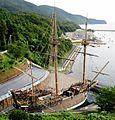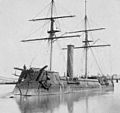Imperial Japanese Navy facts for kids
Quick facts for kids Imperial Japanese Navy(IJN) 大日本帝國海軍 (Dai-Nippon Teikoku Kaigun) |
|
|---|---|

Ensign of the Imperial Japanese Navy
|
|
| Active | 1868–1945 |
| Country | |
| Allegiance | Imperial General Headquarters Ministry of the Navy Navy General Staff |
| Branch | Combined Fleet Navy Air Service Navy Land Forces |
| Type | Navy |
| Engagements | Invasion of Taiwan First Sino-Japanese War Russo-Japanese War World War I Second Sino-Japanese War World War II |
| Commanders | |
| Ceremonial chief | Emperor of Japan |
| Notable commanders |
Isoroku Yamamoto Tōgō Heihachirō Itoh Sukeyuki Prince Fushimi Hiroyasu and many others |
The Imperial Japanese Navy (IJN) was the main navy of Japan from 1868 to 1945. Its Japanese name was Dai-Nippon Teikoku Kaigun, which means "Navy of the Greater Japanese Empire".
The IJN was a very powerful navy. By 1920, it was the third largest navy in the world. Only the Royal Navy (from the UK) and the United States Navy were bigger.
The Imperial Japanese Navy had its own air force. This was called the Imperial Japanese Navy Air Service. They used aircraft to attack from ships. The IJN was the main enemy of the Western Allies in the Pacific War. This was a big part of World War II.
After Japan lost World War II, the Imperial Japanese Navy was officially ended in 1945. Today, Japan has a different navy called the Japan Maritime Self-Defense Force (JMSDF).
Contents
The Imperial Japanese Navy was created in 1868. This was during a time when Japan was becoming more modern. Japan wanted a strong navy to protect its country and interests.
The IJN fought in several important wars. These included the First Sino-Japanese War and the Russo-Japanese War. They also played a big role in World War I.
The navy grew very strong and modern. It had many battleships, aircraft carriers, and submarines. During World War II, the IJN was a major force. It fought many battles in the Pacific Ocean.
The Imperial Japanese Navy was finally dissolved in 1945. This happened after Japan surrendered at the end of World War II.
What happened after the IJN?
After World War II, Japan adopted a new constitution. This constitution has a special rule called Article 9. This rule says that Japan cannot use aggressive force to solve problems with other countries.
However, Japan still needs to defend itself. So, the Japan Self-Defense Forces (JSDF) were created. This group protects Japan if needed.
The part of the JSDF that protects Japan's oceans is the Japan Maritime Self-Defense Force (JMSDF). This is Japan's modern navy.
Related pages
Images for kids
-
The warship of Yamada Nagamasa (1590–1630), a merchant and soldier who traveled to Ayutthaya (Thailand)
-
The Naval Battle of Hakodate, May 1869; in the foreground, wooden paddle steamer warship Kasuga and ironclad warship Kōtetsu of the Imperial Japanese Navy
-
The ironclad Fusō, between 1878 and 1891
-
The ironclad corvette Kongō
-
Marshal-Admiral Marquis Saigo Tsugumichi commanded Japanese expeditionary forces as a lieutenant-general in the Taiwan expedition.
-
The British-built steam ironclad warship Ryūjō was the flagship of the Imperial Japanese Navy until 1881.
-
The protected cruiser Hashidate, built domestically at the arsenal of Yokosuka
-
The Chinese Beiyang Fleet ironclad battleship Zhenyuan captured by IJN in 1895.
-
Holland 1-class submarine, the first Japanese navy submarine, purchased during the Russo Japanese War
-
The semi-dreadnought battleship Satsuma, the first ship in the world to be designed and laid down as an "all-big-gun" battleship
-
The dreadnought battleship Settsu
-
The dreadnought battleship Kawachi
-
Yokosuka Naval Arsenal immediately after the Great Kantō earthquake of 1923
-
Photograph shows the super-dreadnought battleship Nagato, between ca. 1920 and ca. 1925
-
The super-dreadnought battleship Mutsu
-
The planned Tosa-class battleship Tosa being prepared for scuttling at Kure on 31 January 1925.
-
Captain Sempill showing a Sparrowhawk fighter to Admiral Tōgō Heihachirō, 1921
-
Hōshō, the world's first purpose built aircraft carrier, completed in 1922
-
IJN super-dreadnought battleships Yamashiro, Fusō, and battlecruiser Haruna, Tokyo Bay, 1930s
-
Type 91 Aerial Torpedo on IJN aircraft carrier Akagi flight deck.
-
IJN Yamato-class Battleships Yamato and Musashi moored in Truk Lagoon, in 1943
-
Replica of the Japanese-built 1613 galleon San Juan Bautista, in Ishinomaki
-
The sailing frigate Shōhei Maru (1854) was built from Dutch technical drawings.
-
The French-built ironclad warship Kōtetsu (ex-CSS Stonewall), Japan's first modern ironclad, 1869
See also
 In Spanish: Armada Imperial Japonesa para niños
In Spanish: Armada Imperial Japonesa para niños









































